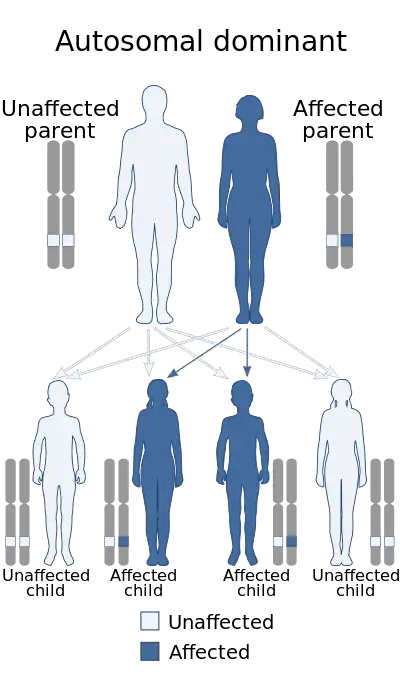Autosomal dominant hypophosphatemic rickets
Autosomal dominant hypophosphatemic rickets (ADHR) is a rare hereditary disease in which excessive loss of phosphate in the urine leads to poorly formed bones (rickets), bone pain, and tooth abscesses. ADHR is caused by a mutation in the fibroblast growth factor 23 (FGF23). ADHR affects men and women equally; symptoms may become apparent at any point from childhood through early adulthood. Blood tests reveal low levels of phosphate (hypophosphatemia) and inappropriately normal levels of vitamin D. Occasionally, hypophosphatemia may improve over time as urine losses of phosphate partially correct.
| X-linked dominant hypophosphatemic rickets | |
|---|---|
 | |
| This condition is inherited in an autosomal dominant manner | |
| Specialty | Endocrinology |
ADHR may be lumped in with X-linked hypophosphatemia under general terms such as hypophosphatemic rickets. Hypophosphatemic rickets are associated with at least nine other genetic mutations.[1] Clinical management of hypophosphatemic rickets may differ depending on the specific mutations associated with an individual case, but treatments are aimed at raising phosphate levels to promote normal bone formation.[2] In a 2019 randomised, clinical trial the rickets in children with X-linked hypophosphataemia treated with a human monoclonal antibody against FGF23 called burosumab improved significantly compared to conventional therapy.[3]
References
- Online Mendelian Inheritance in Man (OMIM): 193100
- "Hypophosphatemic rickets". Genetic and Rare Diseases Information Center. National Institutes of Health. Archived from the original on 12 June 2012. Retrieved 10 October 2012.
- Imel EA, Glorieux FH, Whyte MP, Munns CF, Ward LM, Nilsson O, et al. (June 2019). "Burosumab versus conventional therapy in children with X-linked hypophosphataemia: a randomised, active-controlled, open-label, phase 3 trial". Lancet. 393 (10189): 2416–2427. doi:10.1016/S0140-6736(19)30654-3. PMC 7179969. PMID 31104833.
Further reading
- "Hereditary hypophosphatemic rickets". Genetics Home Reference. September 2010. Archived from the original on 17 September 2012. Retrieved 10 October 2012.
- "Hypophosphatemic Rickets". The Merck Manual Home Health Handbook. Merck Sharp & Dohme Corp. December 2006. Archived from the original on 13 October 2012. Retrieved 10 October 2012.